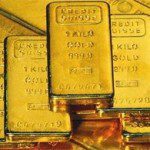The traditional view of portfolio management is that three asset classes, stocks, bonds and cash, are sufficient to achieve diversification. This view is, quite simply, wrong because over the past 10 years gold, silver and platinum have singularly outperformed virtually all major widely accepted investment indexes. Precious metals should be considered an independent asset class and an allocation to precious metals, as the most uncorrelated asset group, is essential for proper portfolio diversification [as this article explains.]
achieve diversification. This view is, quite simply, wrong because over the past 10 years gold, silver and platinum have singularly outperformed virtually all major widely accepted investment indexes. Precious metals should be considered an independent asset class and an allocation to precious metals, as the most uncorrelated asset group, is essential for proper portfolio diversification [as this article explains.]
The comments above & below are edited ([ ]) and abridged (…) excerpts from a research report by Robin Cornwell (catalystresearch.ca)
The objective of this report is to clearly demonstrate that one of the most important investment categories; namely, precious metals (gold, silver and platinum) otherwise referred to as bullion, is an asset class of its own. We further assert that modern portfolio managers, investment advisors, the financial institutions employing these investment professionals [and individual investors alike] are, in fact, not sufficiently diversifying their client’s [or their own] investment portfolios by excluding bullion as an asset class.
The definition of diversification maintains that a balanced investment portfolio should have various weighting of asset classes to be properly balanced. Furthermore, modern portfolio theory tells us that having the right mix of uncorrelated assets reduces risk and improves return. If that is the accepted practice, then why is it that the most negatively correlated asset group to stocks and bonds; namely, precious metals or bullion, has generally been excluded from portfolio diversification as an asset class?
By bullion, we are referring to physical bullion and not a bullion proxy such as the ownership of a mining stock or other alternative investment vehicles. Over the last ten years, the three precious metals have outperformed equities by almost 4 to 1.
Where traditional portfolio thinking went wrong was in the belief that commodity stocks and other alternative investment vehicles were a sufficient proxy for physical precious metals in investment portfolios but, in reality, these so-called proxy investments come with significant risks disassociated with the ownership and performance of bullion itself and do not necessarily provide a direct or pure asset class exposure to commodities.
We contend that these so-called proxy investments add uncertainty as they expose portfolios to other variables such as financial, geographic and political risks which are then layered on top of operational and management issues.
Physical bullion, on the other hand, provides:
- insurance against failure of all other investments,
- better liquidity and is the only asset class (excluding cash) with
- a positive correlation coefficient with inflation, and therefore, the only asset class that can provide
- protection from a systemic crisis.
Once accepted that physical precious metals or bullion should be included as a necessary asset class, then the question becomes just how much of an allocation to physical precious metals or bullion is adequate. Based on historical efficient frontiers, Ibbotson found that including precious metals moderately improved the efficient frontier… [but] based on forward-looking efficient frontiers, Ibbotson found that including precious metals led to asset allocations with higher Sharpe ratios. It was determined that investors could potentially improve the reward-to-risk ratio in conservative, moderate, and aggressive asset allocations by including precious metals with allocations of 7.1%, 12.5%, and 15.7%, respectively.
The allocation to precious metals does not come at the expense of any single asset class, but rather from a reduction in several asset classes. Ibbotson suggests that the unique risk and reward profile of precious metals may make them a useful diversification tool in strategic asset allocations moving forward.
We contend that precious metals should be considered an asset class of its own and that an allocation to precious metals, as the most uncorrelated asset group, is essential for proper portfolio diversification…a portfolio of different kinds of investments will, on average, yield higher returns and pose a lower risk than any individual investment found within the portfolio…
A study done by Ibbotson Associates (“Ibbotson”) in 2005 determined that precious metals are the most negatively correlated asset class to stocks and bonds…The Ibbotson study examined the 33-year period from February 1971 to December, 2004 and determined that the correlation coefficients of annual total returns of various asset classes compared to the U.S. large cap stocks was as follows:
- precious metals:** -0.10
- cash: 0.04
- US intermediate bonds: 0.22
- US long-term bonds: 0.28
- international equity: 0.59
- US small-cap stocks: 0.79
- US large-cap stocks: 1.00
**equally weighted composite index using gold, silver and platinum bullion for comparison
…Of the 7 asset classes mentioned above the precious metals asset class is the only one with a negative average correlation to the other asset classes. As we point out, low correlations between asset classes are essential for diversification…
For the period studied, Ibbotson found that precious metals provided a substantial hedge against inflation. Excluding cash, precious metals is the only asset class with a positive correlation coefficient with inflation and, therefore, the only asset class that can provide protection from a systemic crisis.
1. It is Imperative to Invest in Physical Gold and/or Silver NOW – Here’s Why
Asset allocation is one of the most crucial aspects of building a diversified and sustainable portfolio that not only preserves and grows wealth, but also weathers the twists and turns that ever-changing market conditions can throw at it. However, while the average [financial] advisor or investor spends a great deal of time carefully analyzing and picking the right stocks or sectors, the basic and primary task of asset allocation is often overlooked. [According to research by both Wainwright Economics and Ibbotson Associates and the current Dow:gold ratio, allocating a portion of one’s portfolio to gold and/or silver and/or platinum is imperative to protect and grow one’s financial assets. Let me explain.] Words: 1060
Thanks for reading! Visit our Facebook page (here) and “Like” any article so you can “Follow the munKNEE” and get future articles automatically delivered to your feed.
 munKNEE.com Your Key to Making Money
munKNEE.com Your Key to Making Money



